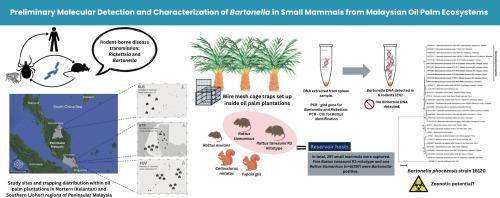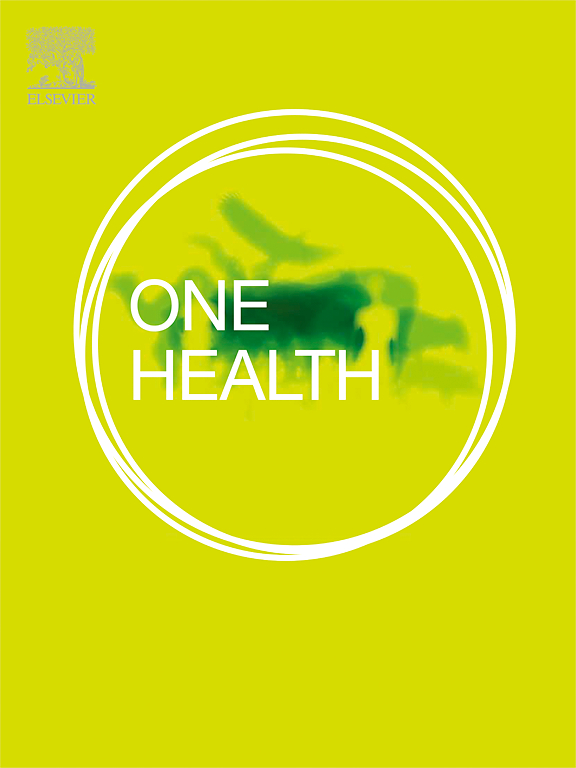Preliminary molecular detection and characterization of Bartonella in small mammals from Malaysian oil palm ecosystems
IF 4.5
2区 医学
Q1 INFECTIOUS DISEASES
引用次数: 0
Abstract
Close contact between humans and wildlife in agricultural landscapes, particularly rodents in oil palm plantations, increases the risk of zoonotic pathogen transmission, with Bartonella spp. emerging as important but understudied cause of febrile illness. The study investigates the presence and genetic characterization of Bartonella in small mammals from Malaysian oil palm plantations to assess the zoonotic risk. A total of 297 animals were trapped and examined, representing five species: Rattus tanezumi R3 mitotype, Rattus tiomanicus, Rattus exulans, Callosciurus notatus, and Tupaia glis. The identification of three Rattus group was further validated using cytochrome c oxidase subunit I (COI) gene analysis. DNA was extracted from the spleen and screened for Bartonella and Rickettsia using conventional PCR targeting the gltA gene followed by sequencing and phylogenetic analysis of positive samples for confirmation and diversity assessment. Molecular screening revealed a 2 % (6/297) prevalence of Bartonella species in five R. tanezumi R3 mitotype and one R. tiomanicus. Conversely, no Rickettsia DNA was amplified from all of the collected samples. All Bartonella-positive samples phylogenetically clustered with Bartonella phoceensis strain 16120, a genotype not currently associated with human disease. However, its detection in predominant rodent reservoir species underscores the utility of a One Health framework. Sustained surveillance using integrated approaches is essential to monitor and mitigate potential zoonotic risks emerging from evolving agricultural landscapes.

马来西亚油棕生态系统中小型哺乳动物巴尔通体的初步分子检测和鉴定
人类与农业景观中的野生动物,特别是油棕种植园中的啮齿动物之间的密切接触,增加了人畜共患病原体传播的风险,巴尔通体正在成为发热性疾病的重要病因,但尚未得到充分研究。本研究调查了马来西亚油棕种植园小型哺乳动物巴尔通体的存在和遗传特征,以评估人畜共患病风险。共捕获检查动物297只,包括5种:黄鼠R3有丝裂型、田鼠(Rattus tiomanicus)、长尾鼠(Rattus exulans)、褐家鼠(Callosciurus notatus)和灰鼠(Tupaia glis)。利用细胞色素c氧化酶亚基I (COI)基因分析进一步验证了三个Rattus组的鉴定。从脾脏中提取DNA,以gltA基因为目标,采用常规PCR筛选巴尔通体和立克次体,对阳性样本进行测序和系统发育分析,进行确认和多样性评估。分子筛选结果显示,5种黄颡鱼R3有丝裂型和1种tiomanicus巴尔通体感染率为2%(6/297)。相反,没有立克次体DNA从所有收集的样本中扩增出来。所有巴尔通体阳性样本在系统发育上都与凤凰巴尔通体菌株16120聚集在一起,这是一种目前与人类疾病无关的基因型。然而,其在主要啮齿动物宿主物种中的检测强调了“同一个健康”框架的实用性。采用综合方法进行持续监测对于监测和减轻不断变化的农业景观中出现的潜在人畜共患病风险至关重要。
本文章由计算机程序翻译,如有差异,请以英文原文为准。
求助全文
约1分钟内获得全文
求助全文
来源期刊

One Health
Medicine-Infectious Diseases
CiteScore
8.10
自引率
4.00%
发文量
95
审稿时长
18 weeks
期刊介绍:
One Health - a Gold Open Access journal.
The mission of One Health is to provide a platform for rapid communication of high quality scientific knowledge on inter- and intra-species pathogen transmission, bringing together leading experts in virology, bacteriology, parasitology, mycology, vectors and vector-borne diseases, tropical health, veterinary sciences, pathology, immunology, food safety, mathematical modelling, epidemiology, public health research and emergency preparedness. As a Gold Open Access journal, a fee is payable on acceptance of the paper. Please see the Guide for Authors for more information.
Submissions to the following categories are welcome:
Virology,
Bacteriology,
Parasitology,
Mycology,
Vectors and vector-borne diseases,
Co-infections and co-morbidities,
Disease spatial surveillance,
Modelling,
Tropical Health,
Discovery,
Ecosystem Health,
Public Health.
 求助内容:
求助内容: 应助结果提醒方式:
应助结果提醒方式:


